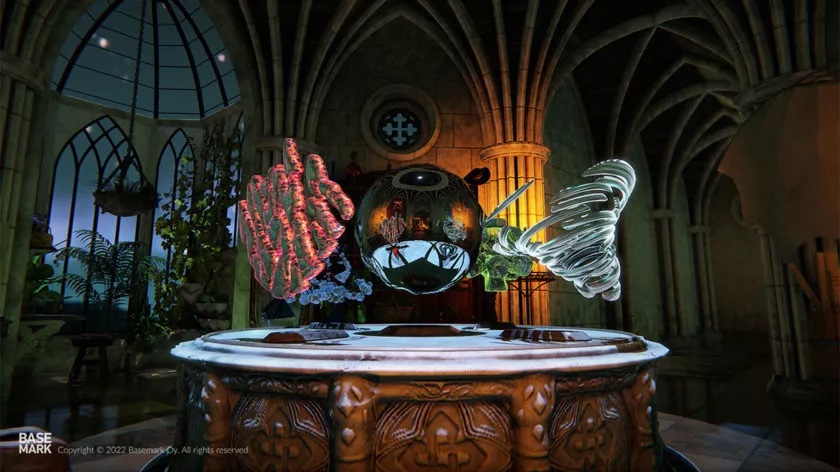Old Exynos chip beats newest Snapdragon in raytracing performance!
Samsung’s first smartphone chipset in partnership with AMD, the Exynos 2200, supports raytracing. It is a new graphics rendering method that calculates how light rays travel to offer a more accurate representation of lights, shadows, and reflections. However, there was no way to measure the Exynos 2200’s raytracing performance back then. A recently released benchmark called In Vitro can measure raytracing performance. It has revealed some surprising results.
The folks over at Android Authority were able to get their hands on Basemark’s new In Vitro gaming test suite. They ran the benchmark on the Exynos 2200-equipped Galaxy S22 Ultra and the Snapdragon 8 Gen 2-equipped Redmagic 8 Pro to check how mobile chips perform in raytracing performance. Which chipset do you think won?
Exynos 2200 raytracing performance beats Snapdragon 8 Gen 2
Basemark’s In Vitro raytracing benchmark only runs on Android devices that have hardware support for raytracing and run Android 12 (or later), Vulkan 1.1 (or newer), ETC2 compression, and at least 3GB of unified memory.
Well, at 1080p resolution, the Galaxy S22 Ultra’s Exynos 2200 chipset performed better, with an average frame rate of 21.6fps (lows of 16.4fps and highs of 30.3fps). The Redmagic 8 Pro, featuring the Snapdragon 8 Gen 2, returned with an average frame rate of 17.6fps (lows of 13.3fps and highs of 42fps). This means the Exynos 2200 is a more reliable performer of the two despite being a year older.
The test reportedly ran smoother on the Snapdragon 8 Gen 2 when there were fewer reflections on the screen. It reportedly struggled hard when the test ramped up while displaying more reflections.
The folks over at Android Authority ran a raytracing stress test that included 20 continuous runs of the In Vitro test. Even here, the Exynos 2200 performed better than the Snapdragon 8 Gen 2 up until 17 test runs and then throttled the performance to manage heat. Still, the Exynos 2200’s average frame rate was 16.9fps versus the Snapdragon 8 Gen 2’s average frame rate of 14.9fps. That says a lot about the Exynos chipset’s Xclipse 920 GPU. Despite being a year older, it defeated the Adreno 740 GPU inside the Snapdragon 8 Gen 2. However, in rasterization, the Snapdragon is clearly faster.
So, it looks like Samsung’s claims about raytracing weren’t just smoke and mirrors, and the Exynos 2200’s hardware raytracing was a generation ahead of its time. AMD and Samsung did some really good things with the Exynos 2200’s GPU. Too bad there aren’t any raytracing games on the Android platform.
This year, the South Korean firm is expected to go exclusive with the Snapdragon 8 Gen 2 processor for the Galaxy S23 (Pre-Reserve Now). Should Samsung consider improving the other areas of Exynos chips and coming back stronger next year with the Galaxy S24? Let us know in the comments section below.
Samsung’s first smartphone chipset in partnership with AMD, the Exynos 2200, supports raytracing. It is a new graphics rendering method that calculates how light rays travel to offer a more accurate representation of lights, shadows, and reflections. However, there was no way to measure the Exynos 2200’s raytracing performance back then. A recently released benchmark called In Vitro can measure raytracing performance. It has revealed some surprising results.
The folks over at Android Authority were able to get their hands on Basemark’s new In Vitro gaming test suite. They ran the benchmark on the Exynos 2200-equipped Galaxy S22 Ultra and the Snapdragon 8 Gen 2-equipped Redmagic 8 Pro to check how mobile chips perform in raytracing performance. Which chipset do you think won?
Exynos 2200 raytracing performance beats Snapdragon 8 Gen 2

Basemark’s In Vitro raytracing benchmark only runs on Android devices that have hardware support for raytracing and run Android 12 (or later), Vulkan 1.1 (or newer), ETC2 compression, and at least 3GB of unified memory.
Well, at 1080p resolution, the Galaxy S22 Ultra’s Exynos 2200 chipset performed better, with an average frame rate of 21.6fps (lows of 16.4fps and highs of 30.3fps). The Redmagic 8 Pro, featuring the Snapdragon 8 Gen 2, returned with an average frame rate of 17.6fps (lows of 13.3fps and highs of 42fps). This means the Exynos 2200 is a more reliable performer of the two despite being a year older.
The test reportedly ran smoother on the Snapdragon 8 Gen 2 when there were fewer reflections on the screen. It reportedly struggled hard when the test ramped up while displaying more reflections.
The folks over at Android Authority ran a raytracing stress test that included 20 continuous runs of the In Vitro test. Even here, the Exynos 2200 performed better than the Snapdragon 8 Gen 2 up until 17 test runs and then throttled the performance to manage heat. Still, the Exynos 2200’s average frame rate was 16.9fps versus the Snapdragon 8 Gen 2’s average frame rate of 14.9fps. That says a lot about the Exynos chipset’s Xclipse 920 GPU. Despite being a year older, it defeated the Adreno 740 GPU inside the Snapdragon 8 Gen 2. However, in rasterization, the Snapdragon is clearly faster.
So, it looks like Samsung’s claims about raytracing weren’t just smoke and mirrors, and the Exynos 2200’s hardware raytracing was a generation ahead of its time. AMD and Samsung did some really good things with the Exynos 2200’s GPU. Too bad there aren’t any raytracing games on the Android platform.
This year, the South Korean firm is expected to go exclusive with the Snapdragon 8 Gen 2 processor for the Galaxy S23 (Pre-Reserve Now). Should Samsung consider improving the other areas of Exynos chips and coming back stronger next year with the Galaxy S24? Let us know in the comments section below.
